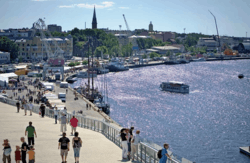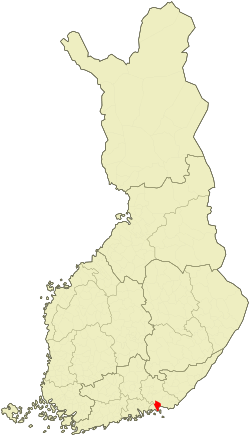Kotka
Kotka (lit. "eagle") is a town in the southern part of the Kymenlaakso province on the Gulf of Finland. Kotka is a major port and industrial city and also a diverse school and cultural city. The neighboring municipalities of Kotka are Hamina, Kouvola and Pyhtää. Kotka belongs to the Kotka-Hamina subdivision, and with Kouvola, Kotka is one of the capital center of the Kymenlaakso region.
Kotka | |
|---|---|
City | |
| Kotkan kaupunki Kotka stad | |
 | |
 Coat of arms | |
 Location of Kotka in Finland | |
| Coordinates: 60°28′N 026°56.5′E | |
| Country | |
| Region | Kymenlaakso |
| Sub-region | Kotka-Hamina sub-region |
| Charter | 1879 |
| Government | |
| • City manager | Esa Sirviö |
| Area (2018-01-01)[1] | |
| • Total | 949.77 km2 (366.71 sq mi) |
| • Land | 271.29 km2 (104.75 sq mi) |
| • Water | 678.45 km2 (261.95 sq mi) |
| Area rank | 239th largest in Finland |
| Population (2019-01-31)[2] | |
| • Total | 52,899 |
| • Rank | 19th largest in Finland |
| • Density | 194.99/km2 (505.0/sq mi) |
| Population by native language | |
| • Finnish | 94.4% (official) |
| • Swedish | 1% |
| • Others | 4.5% |
| Population by age | |
| • 0 to 14 | 14.8% |
| • 15 to 64 | 65.5% |
| • 65 or older | 19.6% |
| Time zone | UTC+02:00 (EET) |
| • Summer (DST) | UTC+03:00 (EEST) |
| Postal code | 48400 |
| Municipal tax rate[5] | 19.5% |
| Climate | Dfb |
| Website | www.kotka.fi |
Kotka is located on the coast of the Gulf of Finland at the mouth of Kymi River and it is part of the Kymenlaakso region in southern Finland. The most important highway in Kotka is Finnish national road 7 (E18), which goes west through Porvoo to Helsinki, the capital of Finland, and extends east to St. Petersburg, Russia. The Port of Kotka is a major Finnish sea port that serves both the foreign trade of Finland and Russia.[6] The municipality is officially unilingually Finnish, with 89.8% being native Finnish speakers, 1% Swedish, and 9.3% speaking some other language. [7]
History
The Second All-Russian Conference of the Russian Social Democratic Labour Party was held in Kotka, on 21–23 July (3–5 August) 1907.
Historically, Swedish was the official language in the city until 1902. From 1902 until 1906, the city was officially bilingual. Kotka has a Swedish speaking minority (see: Swedish-speaking population of Finland), which in the 1890s accounted for 16% of the city population and 3% in the 1950s.[8] Today around 1% of the city's population are Swedish speakers. There is one school in Kotka where Swedish is the language of instruction, Kotka Svenska Samskola, which was founded in 1885.
Kotka region was one of the first heavily industrialized regions of Finland. Paper and pulp mills of Kotkamills and Stora Enso still remain important employers. In the last decades several factories have undergone restructuring which has led to an increasing unemployment. Since the 1980s the population of Kotka has been slowly decreasing, mostly due to domestic migration to Helsinki region.
Culture and Architecture
Maritime Centre Vellamo is home to the Maritime Museum of Finland, the Museum of Kymenlaakso, the Coast Guard Museum, Information Centre Vellamo and the Kotka Cultural Centre. In addition to this, the building holds classrooms, seminar rooms, a 200-seat auditorium, Restaurant Laakonki with 100 seats, and Museum Shop Plootu.
The Kymenlaakso museum operates at the Kantasatama Harbour in Kotka, at Maritime Centre Vellamo. The museum building, which has aroused much attention, was designed by the architect Ilmari Lahdelma. The area of operation of the Kymenlaakso museum, which is maintained by the City of Kotka, covers seven municipalities. The museum information services and the work of the regional archaeologist cover the entire region of Kymenlaakso. In building research, the museum serves as a public authority, with duties such as the issuing of opinions in building protection matters. The collections of Kymenlaakso museum have been compiled since the 1920s. Alongside collections of museum items, the museum has an extensive archive of photographs. The collections are located at Metsola in Kotka.
Langinkosken keisarillinen kalastusmaja is a fishing lodge in the valley of River Kymijoki. Kymijoki is one of the biggest rivers in Finland with a drainage basin with 11% of the area of Finland. Alexander III first visited Langinkoski in 1880 as Crown Prince. During his second visit to Langinkoski, he stated that he wanted a small fishing lodge near rapids. Construction of the house began in the summer of 1888 and was inaugurated the following year. The museum is visited annually by about 14,000 visitors a year.
Maretarium Aquarium opened in 2002, is located on Kotka Island, on the shore of the Gulf of Sapokka. It focuses on the presentation of Finnish fish species and water bodies. There are about 60 native and established fish species from Finland. The Maretarium was created in collaboration between the City of Kotka, the University of Helsinki and the Finnish Game and Fisheries Research Institute. In addition to aquariums, there are also facilities for researchers and the nature school. There is also the Maritime Theater, Meri Café Kristina and a souvenir shop.
The Church of St Nicholas is located in Isopuisto Park in Kotka city centre. Based on designs by Jakov Perrin, the neoclassical church was constructed between 1799–1801, and it is the oldest building in Kotka today. Facade consists of pillars for three entries, the bell tower and a cross dome.
Twin towns — Sister cities
Kotka is twinned with:[9]
|
Sports
The local football team is KTP. Founded in 1927, KTP has long, and successful football history. KTP won the Finnish football championship in 1951 and 1952, and Finnish Cup 4 times, in years 1958, 1961, 1967, and 1980. Currently the club plays in the Finnish second league Ykkönen.
KTP-Basket plays in Korisliiga
Gallery

 Maretarium – Finnish Sea Life
Maretarium – Finnish Sea Life Maritime Centre Vellamo
Maritime Centre Vellamo Sibeliuksenpuisto in Kotka
Sibeliuksenpuisto in Kotka- Mariankatu street in Kotka
- Sunset in Kotka
 Steam locomotive VR Class Sk1 146 at Kotka railway station
Steam locomotive VR Class Sk1 146 at Kotka railway station
See also
References
- "Area of Finnish Municipalities 1.1.2018" (PDF). National Land Survey of Finland. Retrieved 30 January 2018.
- "Suomen virallinen tilasto (SVT): Väestön ennakkotilasto [verkkojulkaisu]. Tammikuu 2019" (in Finnish). Statistics Finland. Retrieved 15 March 2019.
- "Population according to language and the number of foreigners and land area km2 by area as of 31 December 2008". Statistics Finland's PX-Web databases. Statistics Finland. Retrieved 29 March 2009.
- "Population according to age and gender by area as of 31 December 2008". Statistics Finland's PX-Web databases. Statistics Finland. Retrieved 28 April 2009.
- "List of municipal and parish tax rates in 2011". Tax Administration of Finland. 29 November 2010. Retrieved 13 March 2011.
- "Efficient logistics hub for the needs of global traffic". PortOfKotka.fi. Archived from the original on May 31, 2010.
- "Archived copy". Archived from the original on 2017-12-28. Retrieved 2020-02-07.CS1 maint: archived copy as title (link)
- Henricson, Sofie (2005). ""Ingen pratar svenska här" – om svenskan på språköarna". Sprakbruk.fi (in Swedish).
- Hassinen, Raino. "Kotka - International co-operation: Twin Cities". City of Kotka. Archived from the original on 2019-08-22. Retrieved 2013-10-22.
- "International co-operation of Gdynia". Gdynia.pl. Archived from the original on 2016-10-19.
- "Twin-cities of Klaipėda". Archived from the original on 2011-09-28. Retrieved 2011-05-29.
- "Some 15 Finnish towns have twinned with friendship cities in China". Helsingin Sanomat International Edition. 2013-06-20. Archived from the original on 2013-10-23. Retrieved 2013-07-29.
External links
![]()
- City of Kotka – Official website
- Kotka Tourism – Official website of Kotka City Tourist Information

